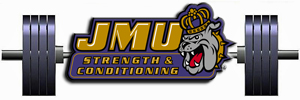 Official
Site of the James Madison University Strength & Conditioning Program Official
Site of the James Madison University Strength & Conditioning Program |
|
|
|
KIN 425 Concepts of Strength & Conditioning Plyometrics: · Activities that enable a muscle to reach maximal force in the shortest possible time · Plyometric exercise is a quick, powerful movement using a pre-stretch, or countermovement, that involves the stretch-shortening cycle (SSC). · When used correctly, plyometric training has consistently been shown to improve the production of muscle force and power.
Muscle Spindles: · Proprioceptive organs that are sensitive to the rate and magnitude of a stretch; when a quick stretch is detected, muscular activity reflexively increases. This reflexive response pontentiates, or increases, the activity in the agonist muscle, thereby increasing the force the muscle produces.
Stretch-Shortening Cycle (SSC): · The basis of plyometric exercise. A rapid eccentric muscle action stimulates the stretch reflex, which increases the force produced during the subsequent concentric action.
Stretch Shortening Cycle
Progression of lower-body Plyometric Drills 1. Jumps in place [vertical jump] 2. Standing jumps [broad jump] 3. Multiple hops and jumps [hurdle hops] 4. Bounds [sprint bounding] 5. Box Drills 6. Depth Jumps
Rest: · Complete and adequate rest is required between sets of plyometric drills
Surface · To prevent injuries, the landing surface used for lower-body plyos should possess shock-absorbing properties. Footwear · Footwear with good ankle and arch support, good lateral stability; and a non-slip sole is recommended. |
|
Number of visitors since 9/15/04
This is the official website of the James Madison University Strength & Conditioning program. Please direct any comments or questions to Greg Werner, Director of Strength & Conditioning. Date this site was last updated 01/06/2009 08:53:51 PM |